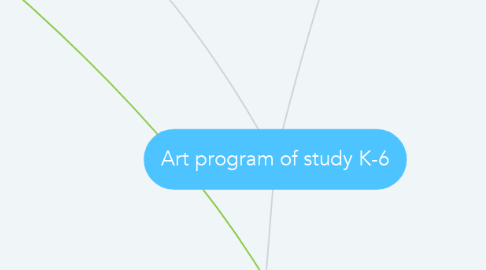
1. Rationale and Philosophy
1.1. Organization of visual materials
1.1.1. Acquiring proficiency in Art requires systematic instruction in how we see, interpret and make sense of visual stimuli.
1.1.2. Requires an education in the use of traditional and contemporary tools, materials and media.
1.2. Have individuals think and behave as artists
1.2.1. Realizing that practicing Art changes the individual, their relationships with others, as well as their social and physical environments
1.3. Pointing out the values that surround the creation and cherishing of art forms
1.3.1. Relative values are given to art products. These values not only tell us about the artists who created them, but also reflects how values change over time
1.4. Expression of feelings in visual forms
1.4.1. The focus of study within Art surrounds the human condition. Participants involved in visual arts reflect upon and externalize their personal feelings and intuitions.
1.4.2. Visual artists share this ability with writers, poets and musicians. By recognizing these relationships with both the performing and literary arts, a sense of common purpose is produced.
1.5. Making and defending qualitative judgments about art
1.5.1. Becoming a perceptive critic attunes the individual to the unique contribution of the artist
1.5.2. A sense is gained that not all art is the same
1.5.3. It is necessary to be able to articulate reasons for preferring one work over the other.
2. General Learner Expectations (EXPERIENCES)
2.1. Individual
2.1.1. Art education is ultimately for the self-realization of the individual. Students should be enabled to grow their sense of independence, individuality, self-realization, self- awareness and creativity.
2.2. Learning
2.2.1. Art Education involves skill development in the areas of drawing, painting, print making, sculpture and fabric, photography and technographic arts.
2.3. Communication
2.3.1. Visual images communicate to the individual and the individual can communicate through visual images. Art Education is visual reading and expression
2.4. Creative
2.4.1. The language of art is available to all and can be used to express both thought and feeling. Art education encourages the use of imagination, inventiveness and a spirit of inquiry
2.5. Cultural
2.5.1. Art is a part of humankind’s heritage and art education is concerned with valuing, reflecting and appreciating this legacy.
2.6. Environmental
2.6.1. Environment - natural and man-made - affects the individual. Art education is concerned with informed choices of manufactured items and quality environment.
3. LEARNER OBJECTIVES
3.1. REFLECTION
3.1.1. Students will notice commonalities within classes of natural objects or forms (level 1)
3.2. DEPICTION
3.2.1. Students will represent surface qualities of shapes and forms (level 1)
3.3. COMPOSITION
3.3.1. Students will improve compositions by refining, rehearsing and critiquing (level 2)
3.4. EXPRESSION / ARTICULATION
3.4.1. Students will record or document activities, people and discoveries (all levels)

